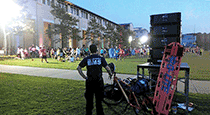 Laura Carroll (S’15) is sound asleep until a sudden, blaring paging tone from a radio jolts her out of bed. It’s not her alarm clock or a fire drill; the CMU police are hailing her because she is a member of the college’s emergency medical service (EMS). Someone needs help at Skibo Gym. Carroll grabs her kit and sprints to the gym, where she is joined by other EMS members. They find a student in respiratory distress, barely able to breathe after being stricken by a severe asthma attack.
Laura Carroll (S’15) is sound asleep until a sudden, blaring paging tone from a radio jolts her out of bed. It’s not her alarm clock or a fire drill; the CMU police are hailing her because she is a member of the college’s emergency medical service (EMS). Someone needs help at Skibo Gym. Carroll grabs her kit and sprints to the gym, where she is joined by other EMS members. They find a student in respiratory distress, barely able to breathe after being stricken by a severe asthma attack.
The EMS members are trained to know what to do for campus medical emergencies. Certified as EMTs, they’re usually the first on the scene because of their proximity to campus and are considered the first level of “medical help.” Typically, they’re involved in 400-600 calls per year, treating a host of health issues such as difficulty breathing, chest pain, bleeding, high fever, disorientation, vomiting, loss of consciousness, head injury, and a variety of illnesses. If they determine advanced medical care is needed, their job is to ensure that the student stays safe, calm, and stable until help arrives. The group is under the medical direction of the University of Pittsburgh Medical Center and maintains strong ties to the Pittsburgh EMS and the CMU Police Department.
Carroll and the other student volunteers stay on call for 24-hour shifts, providing round-the-clock care on campus and in nearby residences. Interestingly, very few of the approximately two-dozen volunteers aspire to a career in medicine. “The thing bringing us together is the passion we each have for public safety,” says Executive Director Jeff Cooper (CS’14). “We don’t mind being awakened in the middle of the night if there’s someone who may not be able to wait until morning.”
Back in Skibo Gym, Carroll and the other on-call EMS students rush to the student having an asthma attack. The EMS crew chief assesses the problem, determines the best course of action to follow, and delegates responsibilities: Some team members race for a breathing device called a bag-valve mask while others contact paramedics, explaining to them the situation they’ll encounter when they arrive.
A few minutes later, when help arrives, the paramedics praise the student volunteers for relieving the stricken student’s breathing problems. As a precaution, the patient will go to the hospital for observation, but the paramedics don’t foresee any complications. Carroll and the other EMS students can go back to bed.



